by Týra Sahsnotasvriunt
WHY IS NEW YEAR’S CALLED SILVESTER IN GERMAN?

Since the introduction of the Gregorian calendar in 1582 the last day of the year has been named after the Roman Catholic pope Silvester (Lat. silva = forest, silvester = forest (hu)man), who had died on December 31st, 335 in Rome.
For some reason most people pronounce it “Sylvester” (y = ü) rather than Silvester up here though.
Like most Catholic clerics pope Silvester was an incredibly degenerate and cruel man. He was known for torturing Pagans resisting to be baptized to death by forcing them to eat fishbones.
RUMMELPOTT & MASQUERADE

I already mentioned the North Frisian variant of Rummelpott (“noisy pot”) in https://paganmeltingpot.wordpress.com/2015/01/25/pagan-remnants-of-north-frisian-holiday-celebrations-and-customs-19th-21st-century/.
However in most of the rest of Northern Germany the children put on costumes and masks, so that the spirits of the old year would not recognize them and try to pass over into the new year by clinging to them. Groups of children would then go from door to door singing songs such as “Fru, mok de Dör op” swinging their Rummelpott rhythmically and asking for food, candy, a few coins or other small good luck tokens such as pig, horseshoe, chimney sweeper, toadstool or clover figurines.
Unfortunately this custom has been dying out rapidly ever since the introduction of the American commercialized version of Halloween around 1998.
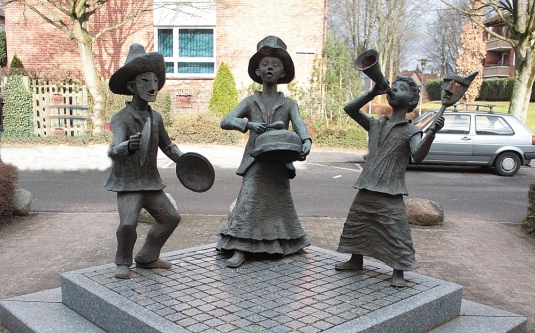
When I was a girl some 30 years ago my family and I would still masquerade ourselves and keep the masks on until midnight, so that the spirits would not recognize us. Children nowadays aren’t even ware of this custom anymore though. People usually either wear little party hats you can buy at the drugstore before Silvester or nothing at all.
RUMMELPOTT TEXTS in Plattdüütsch (Saxon Platt or generally mistakenly known as “low German”)
Fru, maak de Döör op, Wife, open the door,
de Rummelpott will rin, the Rummelpott wants to come in,
dor kummt en Schipp ut
Holland an, a ship from Holland just arrived,
dat hett en goden Wind. which had a good wind.
Un wenn dat Schipp vun
Holland kummt, And when the ship arrives from Holland,
denn hett dat goden Wind, then it has had good wind,
un wenn de Schipper vun
Holland kummt, and when the sailor is from Holland,
denn hett he n goden Sinn. then he is a strong-willed fella.
Schipper, wullt du wieken, Sailor, do you want to move away now?
Fährmann, wullt du strieken, Ferryman, do you want to strike?
sett dat Seil op den Topp Stow the sails on top (=away)
un giff mi wat in n
Rummelpott. and put something into my Rummelpott.
Laat mi nich to lang stahn, Do not let me stand here too long,
ik mutt noch en Huus
wedder gahn, I have to move on to the next house,
halli halli hallo, helli, helli, hello,
dat geiht na Holland to! Now we are off to Holland!
Halli halli hallo, Helli, helli, hello,
n Appelkoken dorto, Give me an apple pie also,
en Stück Speck un en
Stück Broot, A piece of bacon and a slice of bread,
dat is goot för Hungersnoot. that helps against starvation.
In düt Huus wahnt n
rieken Mann, A rich man lives in this house,
de uns de Büdel füllen kann, who can fill our bags,
een, twee, dree, veer, one, two, three, four,
wenn’t ok en halven Daler wee if only it were just half a coin.
Rummel, rummel um dat Huus, Rummel, rummel around the house,
hesst keen Ei, denn geev mi
n Wurst, if you have no eggs give me sausage,
een vun de witten, one of the white ones,
de swatten kann ik nich bieten. I can’t chew the black ones.
Witten Tweern un
swatten Tweern, White thread and black thread,
dat ool Wief dat gifft nich geern! that old housewife doesn’t like to be generous!
Hau de Katt den Swanz af, Chop off the cat’s tail,
hau em nich to lang af, Chop it good and short,
(literally: Don’t chop it (leave it) too long)
laat n lütten Stummel stahn, let (only) a little stump remain,
de Rummelpott mutt
weddergahn! the Rummelpott has to move on!
Een Huus wieder wahnt
de Snieder, One house down lives the tailor,
een Huus achter wahnt
de Slachter, one house behind that one the butcher,
een Huus wiederan one house up lives Santa Claus,
wahnt de Wiehnachtsmann,
un in dat Huus in e Mitt and in the house in the middle
wahnt de dicke Smitt! lives the fat smith!
Ooltjohr, Niejohr, Old year, new year,
Moder, sünd de Förten goor? mother, are the Berliner done?
Sünd se goor, so giff mi n poor. If they’re done yet then give me a few.
Krieg ik een, so bliev ik stahn, Give me one and I shall remain,
krieg ik twee, so will ik gahn. Give me two and I shall leave.
Sünd se n beten kleen, If they’re a wee bit small,
so gifft dat twee för een. then give me two for one
Sünd se n beten groot, If they’re a little big,
so smeckt se mal so goot. at least they’re going to taste well
Sünd se n beten fett, If they’re a bit greasy,
denn smeckt se ok noch nett! it will still taste well enough!
Un giff mi nich to knapp, Don’t be greedy,
dor sünd noch welk int Schapp! There are some left in the wardrobe!
Man ümmer her, man ümmer
her, Give me, give me,
dat Schapp, dat is noch lang
nich leer! the wardrobe isn’t empty yet!
*
Ik bin en lütten König I am a little king
giv mi nich so wenig Do not give me too little
lot mi nich so lange stohn Do not let me stand here too long
denn ik mut noch wedder gohn Because I have to leave soon again
mutt noch ganz nach Bremen Have to get all the way to Bremen
Bremen is ne grode Stadt Bremen is a large city
giv mi all de Lüd wat Where all the people will give me sth.
mi wat, di wat,
all de lütten Kinner wat. Something for me, something for you, something for all the little children
*
“Rummel Rummel rusch Noisy, noisy woosh
De Neger sit in´n Busch The negro sits in the bush
Gif mi eenen Appelkoken Give me some apple pie
Oder eene Wursch Or a sausage
Is de Wursch to kleen If the sausage is too small
Gif mi twee för een Give me two for one
Een Hus wider wohnt de Snider One house down is where the tailor lives
Een Huus achter wohnt
de Schlachter Another house down the butcher
Een Huus achtern leevt
de Wiehnachtsmann And behind that house lives Santa Claus

Foreigners are often put off by how rude and violent these songs seem to be (much like they are afraid of Krampus, the Perchtenlauf and Knecht Ruprecht for example).
But in these kinds of songs several Pagan elements and codes were often hidden. For example said “tailor” in the song above was a code for the Norns, weavers of fate. The butcher was Thunar (Thor) and Santa Claus obviously is Wotan.
The part about the cat in the first song above represents the death of Paganry. Cats used to be regarded as animals connected to the Gods, they appear in lore (Freija’s cats, Thor wrestling the Midgardserpent in disguise of a cat) and were held in high regard, they were also a symbol for magic and the otherworld. In the middle ages cats came to be viewed as bringers of bad fortune, a symbol of the devil and everything “Pagan”, i.e. evil though.
The chopping off of the cat’s tail describes the violent Christianization of Northern Europe – but alas – a stump remains, our roots, our history and customs which might have been taken over, christianized but not entirely eradicated.

GOOD LUCK SYMBOLS
THE FOUR-LEAF CLOVER
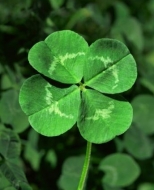
The four-leaf clover is rare and thus it was considered lucky even in pre-Christian times. Later of course, Christians re-interpreted the four-leaf clover to represent the cross, due to its form. But in old times the four-leaf clover was a magical weed, its leaves representing the elements, the cardinal points, the seasons, the sun and sunwheel, which is why it has been popular to keep around the house and close to the body around Yule, the time the sun is reborn.
In Northern Germany grocery and drug stores offer pots of clover about a week before New Year’s Eve. They usually come with little figurines of other good luck symbols.
Usually every member of the family buys their own pot over clover. The family then sits down together, checking for a four-leaf. Four-leafs are often cut off and framed or dried and put in one’s purse to attract money.
THE PIG

The pig is another lucky symbol from Pagan times. The boar is one of Wanen God Fro (Frey)’s totem animals, representing fertility, good fortune, joy and especially prosperity. It appears to have been a sacrificial animal as well, as all throughout Germany boar and pig tusks, bones have been found around ritual areas.
The belief that pigs are “unclean”, unworthy and lower animals is a judeo-Christian one completley foreign to us Europeans.
There are several things and idioms reminding us of the pig symbolizing prosperity and good fortune even today. The piggy bank or the old German saying “Schwein gehabt!” (Literally: “You have (had) pig!” meaning “You are lucky!”) for example.
Since boars were also among the animals in Frau Harke’s (Holle, Holda, Frija) Wild Hunt, chasing away the old year and ringing in the new one they still have significance to our contemporary New Year.
Northern German favorites are Marzipan in the shape of a pig or a “good luck penny” with a tiny plastic pig attached to it so as to act as a charm to attract money.

Fro on his boar and his sister Freija with her cat-drawn chariot
THE HORSE SHOE

As I have mentioned on this blog many times the horse was an especially sacred animal to Pagans in Northern Germany.
Touching especially white horses was considered a goog luck charm up until the 19th century. Likewise the horse shoe remains as a symbol of good luck. Although nowadays miniature horse shoes are sold in stores before New Year’s the actual folk belief was (is) that one must obtain a used horse shoe, preferably from a horse they own, know or at least have seen and touched before.
It is essential for the charm to work that the horse shoe be hung up with the entrance up, so the good fortune will “fall” into it and remain there. Horse shoes are usually hung up above the front door.
TOADSTOOL
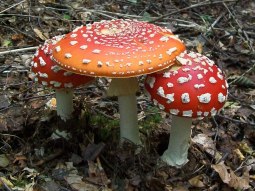
The toadstool has been used for shamanic travels in pre-Christian times especially.
It is highly poisonous, so I just want to make perfectly clear I am not advocating or recommending the use of this in any way.
The recipe for the medieval “Flugsalbe” (flight ointment) can be found online and in quite many witches’ grimoires, history books on witchcraft etc.
So because of the alleged clairvoyance and knowledge of the future the toadstool is said to bring, it is of course considered another symbol of good fortune. For if you know your future, even a dark one, you may just as well change it for the better.
CHIMNEY SWEEP
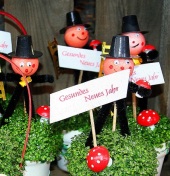
The chimney sweeper is a relatively modern good luck symbol, at least it does not stem from Pagan times but from the late 18th century where a functional exhaust/chimney was essential to keeping the whole house running. (Cooking, warmth, etc.)
New Year’s Eve or not, seeing a chimney sweep is considered a good omen, in Germany they still wear their traditional uniforms and as reserved and cold-natured as we are, whenever we see one we run up to him asking permission to touch his jacket or his buttons, so a little of his luck will rub off on us.
PENNY
Putting a penny in your wallet, under your pillow or putting it with your four-leaf clover pot is believed to be a guarantee for prosperity and good luck in the new year. There’s obviously no Pagan tradition connected to this either.
SCALE OF A CARP
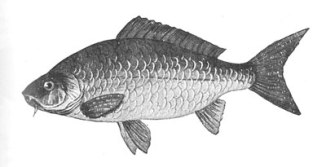
This is actually a Southern German and essentially Catholic tradition that has found its way up to the North unfortunately. It is directly related to pope Silvester torturing Pagan’s to death by forcing them to eat fishbones. The Silvesterkarpfen (New Year’s Carp) enjoys great popularity in some rural parts up North, although people are mainly atheist or Protestant up here. Counting the fishbones after the Silvesterkarpfen dinner was to “count your blessings”. To keep a scale of the carp in your wallet is said to ensure prosperity throughout the whole next year.
DECORATIONS in general
Multi-colored garlands or banners are hung all over the house. What appears to be a modern tradition was actually known in the 19th century already though. This was another way to ensure that the spirits of the old year would not recognize the house and its owners and hopefully move on.
ORACLES
POURING LEAD
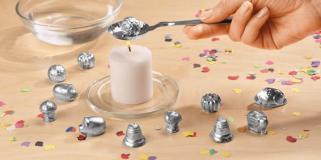
Pouring lead has been practiced in Pagan times already. I have not verified this, but I assume that the Romans brought this custom with them to “Germania”.
Lead pouring sets are also sold in most grocery and drugstores in the North about a week before Silvester.
They usually contain 4-6 pieces of lead in the shape of good luck symbols, a spoon and a little brochure.
Most families pour lead about an hour before midnight. You melt the lead on the spoon over a candle and once molten pour the lead into a bowl of cold water.
ATTN.! You can NOT use this bowl in the kitchen, for the preparation of food, anymore afterwards! This is why many people either buy a cheap bowl that they toss afterwards or keep a special lead pouring bowl for this occasion!
When you retrieve your piece of lead you and your family will examine its shape, could it be an animal? An object, a face…? Once you have made up your mind you look up the meaning of your symbol in the little brochure. Most of them are rather limited so my family and I always kept the 10 volume “Handbuch des deutschen Aberglaubens” at home, not just for lead pouring though. 😉
ORACLE BON BONS
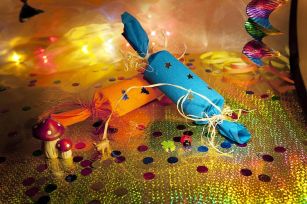
Another modern one: Giant confetti-filled bon bons are another way of predicting the future. One person grabs one end and another family member of friend the other and then you pull it apart. The person holding the longer end is believed to have a luckier year than the other person. (This custom is similar to the one where chicken or other animal bones are pulled apart.)
OTHER BELIEFS, SUPERSTITIONS & CUSTOMS
LAUNDRY
It is believed to bring bad luck to hang up your laundry to dry over New Year’s, as the spirits of old attach themselves to the clothes and hide inside them to enter the new year this way.
They will then continually keep you back, put obstacles in your way and they might even make you mad.
Another folk belief is that disease and death will sneak into the clothes and make you and yours sick.
STRANGE ANIMALS

If one comes across strange animals during the 12 Rauhnächte (twelve nights of Yule) one is supposed to move away from them as quickly as possible. These animals might be connected to the Wild Hunt and/or possessed by spirits, which is why touching them was considered a risk as spirits are also passed on via touch.
BROOMBINDING
Making a new broom on New Year’s was considered to bring good luck. On the stroke of midnight women often began sweeping counter-clockwise around the house in order to purge the old year and the spirits of old from the ground.
TELEVISION

Unrelated to anything Pagan but a modern tradition that began in the 60’s ad 70’s is to watch the original British “Dinner for One” and the episode “Der Silvesterpunsch” (The New Year’s Eve Punch) from the popular 1970’s TV show “Ekel Alfred” (Jerk Alfred). You can find both of them on youtube.

FOOD & DRINK
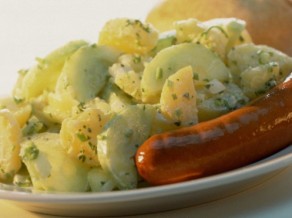
Traditionally most of us in the North (Hamburg, Schleswig-Holstein and parts of Lower Saxony) have potato salad with sausage and mustard (Kartoffelsalat mit Würstchen) on New Year’s Eve.
This tradition stems from the late 18th century. For once, it is easily prepared and the ingredients rather cheap.
On Christmas people usually spent a lot of money on food, gifts and donations to their local church, so there was not a lot of money left at the end of the month for a lavish feast.
The housewife had been busier than usual all throughout December, first with St. Nicholas Day and Christmas preparations and then sowing costumes for the children, making a Rummelpott and decorating the house among other things, so on New Year’s she was happy not to spend half the day in the kitchen but be able to rest and enjoy New Year’s with her family.
Since the late 1960’s many people have moved on to having Fondue on New Year’s Eve also. Potato salad and sausage were considered “poor people food” and in the golden 60’s, our “Wirtschaftswunder” years, people were insanely happy to be able to afford a large amount of quality meat, so many of our traditional dishes were either replaced or modified to include meat or anything but than sausage.

Berliner (in Platt: Förten or Futtje pronounced futtshah) have been a popular New Year’s Eve dessert since the late 18th century as well. Berliner are a kind of donut filled with strawberry jam although in the past twenty years popular fillings include plum marmelade, strawberry-charmpagne marmelade, Bailey’s cream, vanilla cream, nougat cream, apple cinnamon marmelade and a few others. These kinds of donuts are either glazed or covered in sugar or powdered sugar.
This tradition stems from a Berlinian confectioner who was drafted to serve as a gunner in Frederic the Great’s army in 1750. Unsurprisingly he was considered unfit for this task and instead accompanied the army as their personal baker.
Half out of gratitude and half as a joke he began baking “sugar cannon balls” – our Berliner.
Why exactly this dessert is traditionally consumed on New Year’s Eve is a mystery though. It’s possible Friedrich the Great had something to do with it, since he was also the one introducing the potato to the Germans (who were at first rather reluctant about this “strange fruit” as they called it), but this is mere speculation.

Friedrich der Große
An important tradition is the mustard Berliner (Senfberliner). One of the Berliner is filled with mustard and put on the dessert tray among the others. The person who unwittingly picks the mustard one is considered to be especially lucky in the upcoming year. (Edit: I just read that in other parts of Germany it is the other way around.)
Neither books nor online resources offer much in terms of where this belief originates. I personally believe that – since many of our current New Year’s tradition are heavily influenced by Christianity – this might be one of them. In Luke and Matthew the mustard seed is basically equated with faith, the kingdom of heaven, (spiritual) prosperity and good fortune. So all things that people usually wish each other and for themselves for the new year.
I should mention that of course the mustard Berliner, once discovered, is not consumed. We might be quirky, but not quirky enough for that.
RECIPE for NORTHERN GERMAN POTATO SALAD:
1kg potatoes
1 jar of mayonnaise or Miracle Whip
1 jar of sour cucumbers
salt, pepper
Boil potatoes in salt water for 20 minutes. Chop into 2×2 cm large chunks. Chop onions into tiny pieces, fry until golden yellow. Chop cucumbers into ca. 0,5-1cm large bits. Combine everything in a large bowl. Add mayonnaise (as much as you like) and some of the cucumber juice from the jar. Add salt and pepper. Let sit and/or refrigerate for 1 hour.
Northern Germans love to drink champagne or Feuerzangenbowle (Burnt Punch) on Silvester.
RECIPE for BURNT PUNCH for one person:

1 bottle of dry red wine
250g sugar loaf
1/4 orange
1/8 lemon
1-2 cloves
1 teaspoon of cinnamon
1/4 of a bottle of Rum
Heat up everything – save for the Rum – nicely, do not let boil though. Put sugar loaf on the fire tongs, drip some Rum on top, and – CAREFUL, HIGHLY FLAMMABLE!!! – set aflame. Once caramellized drop sugar loaf into the mug of punch, stir and –
Enjoy!
MIDNIGHT

On the stroke of 12 people shout “Happy New Year”, clapping, hugging, toasting the new year with champagne (“Prost Neujahr”! – Cheers to the New Year!) and then going outside to fire rockets, bangers and special Silvester cannons.
I personally detest that this modern custom replaced the tradition of swinging your Rummelpott at the new year, clapping and stomping loudly or making loud music in order to scare the spirits of old away and welcome the new.
For once as someone who has grown up in a rural area it frightens pets and farm animals horribly.
And then also it is an incredible waste of money that could certainly be put to better use (donations anyone?) on top of being rather bad for the environment. The air is thick with smoke for several days at a time afterwards and the plastic rockets, wrappers, etc. are found everywhere and anywhere up until late February.
The 1st of January is an official holiday where no one works.
Dec 30, 2015 @ 21:15:40
Reblogged this on My Journey Through Miðgarðr.
LikeLike
Dec 30, 2015 @ 23:06:50
What a wonderful collection of traditions, thanks for posting this. I especially love the guising connected with the New Year; it’s a strong tradition that sees echoes across the Germanic world in a variety of different specific ways.
Do you happen to know if there are specific types of masks (animals, devils, etc.) that are associated with the tradition? The ones in the photo of the statue seem pretty generic.
LikeLike
Dec 31, 2015 @ 01:07:23
Thank you for your feedback. Yes, I ought to have included that, sorry. Most of the masks used to have demonic, evil- or grim-looking faces painted on them, green, black and red were dominant colors. Quite a few used to have horns and tusks and some were just masks of scary looking animals. (Wide-eyed owls, hissing cats for example.)
For smaller children there were cute or less scary masks of princesses and fairies as well though, at least in the early to late eighties before the tradition started dying out almost altogether.
LikeLike
Jan 16, 2016 @ 21:41:24
Fascinating collection of German customs with helpful commentary! My heritage is about 60% German with the remainder being English, Scottish, and supposedly a little Irish. At this point in life, it’s well past time to research my German roots.
LikeLiked by 1 person
Jan 17, 2016 @ 12:59:41
Thanks for your feedback, Susan. 🙂
LikeLike